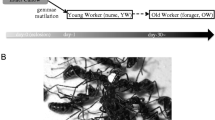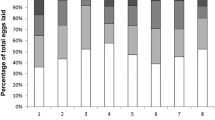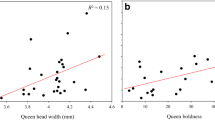Summary
In the Epiponini, queen number may vary from many to few during the colonial cycle. This cyclical oligogyny may be important for the maintenance of high genetic relatedness found in several taxa of epiponines. Even though queen reduction in accord with the colony cycle has either been demonstrated or inferred for many taxa, the factors responsible for queen number reduction remain largely unknown. In this study, behavioral interactions (queen-queen and queen-worker) were analyzed in Asteloeca ujhelyii. Conflicts among queens leading to queen elimination were more intense during colony establishment, and queens’ behavioral performances were significantly correlated with their potential reproductive capacity. Frequency of workers’ testing behaviors toward queens did not relate as a function of the colony cycle. Thus, it seems that in Asteloeca ujhelyii cyclical oligogyny is indeed behaviorally mediated.
Similar content being viewed by others
Author information
Authors and Affiliations
Corresponding author
Additional information
Received 16 January 2003; revised 1 June 2003; accepted 3 July 2003.
Rights and permissions
About this article
Cite this article
Nascimento, F.S., Tannure-Nascimento, I.C. & Zucchi, R. Behavioral mediators of cyclical oligogyny in the Amazonian swarm-founding wasp Asteloeca ujhelyii (Vespidae, Polistinae, Epiponini). Insect. Soc. 51, 17–23 (2004). https://doi.org/10.1007/s00040-003-0696-y
Issue Date:
DOI: https://doi.org/10.1007/s00040-003-0696-y




